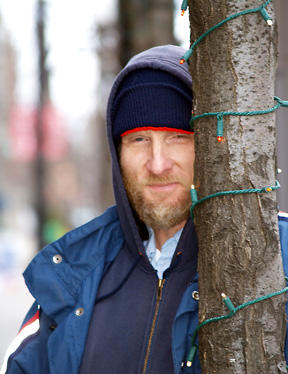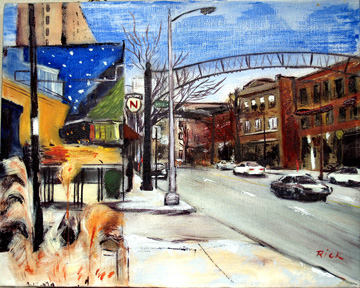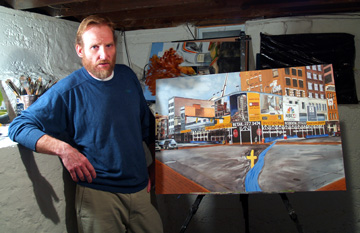
Columbus, Ohio USA
Return to Homepage www.shortnorth.com
Rick Blackburn:
Mail carrier, artist and friend
- all in one package
Feburuary 2007
by Jennifer Hambrick
email jmhambrick@yahoo.com
© Photos by Rick Borgia
Rick Blackburn delivering mail and friendship in the Short North. Even in the age of high-speed e-mail and instant messaging, finding a letter in the mailbox is still a significant event. Written in the intimate space of the page and swaddled in secrecy by protective envelopes, letters propel the human drama that is life, sometimes bringing us closer, sometimes pulling us apart. The love letter, for example, bursts forth from its envelope with the ripeness of hope that two souls may find companionship in each other. The Dear John letter, on the other hand, severs ties in the most private, most distant and most final way. Nothing warms the heart and brings present and past together like a letter from an old friend, while business letters bring news about the important things that sustain life – paychecks, bank accounts and so on.
Rick Blackburn has been delivering letters for 22 years, the last seven of which have been in the Short North. Though he couldn’t tell you what they say, he knows the letters he delivers to his clients on High Street between Goodale and Hubbard and in Italian Village will change lives in some way, great or small. So he takes his job, and the people he serves, very seriously.
Though Blackburn says he doesn’t work his route to make friends, he has made friends. Many of his clients know his name and recognize him as their friendly neighborhood mail carrier. And more recently, they’ve gotten to know him as an artist, some even exhibiting his paintings in their High Street shops. As both an aspiring artist and the glue that holds the people on his route together, Blackburn embodies the artistic bent and community spirit of the Short North.Loading and Unloading, Part I
If you had asked the young Rick Blackburn what he wanted to be when he grew up, he might not have been able to tell you, and he almost certainly wouldn’t have said he wanted to be a mail carrier.
Born in Columbus in 1956, Blackburn graduated from Westland High School in 1973 and says he spent much of his young adult years seeking work that was both stable and interesting. After finishing high school, he did warehouse and loading dock work for Sears Roebuck Co. for four years before taking a job doing piece work on General Motors’ Columbus assembly lines. His father had driven a die truck at the General Motors plant in Columbus so, in a way, Blackburn was following in his footsteps.
But he wasn’t ready to settle into a factory job. In the late 1970s, he enlisted in the Army and for four years was stationed on a freight ship that sailed a regular route between Boston and Panama. When the ship put in on the coast of North Carolina, South Carolina and Florida, Blackburn and his shipmates would load and unload all manner of cargo, board the ship again and sail to the next port of call.
During the late ’70s, while he was working for GM, Blackburn took some night courses in painting at Ohio State and the Columbus College of Art and Design. But after a while he had had enough of painting, and stopped doing it altogether.
“The whole desire to do it just wasn’t there,” Blackburn said.Loading and Unloading, Part II
When Blackburn was discharged in the early ’80s, he returned to Columbus and pounded the pavement for work. He painted houses for a few months, but it wasn’t a good fit. Then he got a job working part-time with the U.S. Postal Service, pinch-hitting for full-time mail carriers when they were out sick or had a day off. After a couple of years, he was allowed to bid for a route of his own. He bid on a route around Fifteenth and High, on OSU campus, and worked that route full time for 13 years.
“It’s kind of an interesting route,” Blackburn said. “You’re up there with all those college people, and whenever you’re in the college environment, there’s always something going on.”
The students who lived in the OSU fraternity and sorority houses made up a large portion of Blackburn’s clients on his campus route, but he remembers other people on the route more vividly.
“The street people are the ones that kind of stand out to me,” Blackburn said, “because that’s a whole ’nother existence that goes underneath the radar. Being a letter carrier, you’re not of that world, but you’re kind of in it. I got to know all the street people, the panhandlers, maybe the alcoholics, the people that are kind of on the margins of society. Every once in a while, you’ll see someone turn their life around. I would try to befriend these people if I could. I would establish relationships with them and try to talk to them and try to help them out.”
Blackburn says many of the street people on his route had alcohol or drug addiction problems, or had been sexually abused. Though some of these people were unable to express themselves coherently, he says others would freely unload their problems when they knew he’d listen. Then he’d ask them if he could pray for them, or even with them.
“Usually they’d say, ‘Yeah,’” Blackburn said. “Sometimes these people are carrying around some things inside that they need to get rid of.”
Blackburn says he never lost sight of the fact that he was there to do a job. Still, he felt compelled to help people in need, and didn’t let it interfere with his work.
“I’m not really out there to make friends, even though that happens as a by-product. It’s a professional job. I try to be professional, and part of that is being friendly. You want somebody to be friendly. Why not? It doesn’t cost you anything.”
Rick Blackburn's painting of High Street looking south includes a view of the
Norka Futon building with the mural of Van Gogh's Café Terrace at NightA Friend For All Seasons
When Blackburn left his campus route in the mid-1990s, he worked on a route in Grandview Heights for three years before coming to his current route in the Short North. He was delivering mail one day when his painting muse revisited him.
“I was carrying around Goodale Park, it was in the springtime, and I saw a lady painting the pond over there. And I just went over there and got to talking with her, and she told me that she was involved with the Columbus Cultural Arts Center and that she was taking painting there. Something clicked within me that said, ‘Well, you do this now.’”
Blackburn enrolled in painting and drawing classes at the Cultural Arts Center and pursued his passion for painting during his downtime from work.
Over the years delivering mail in the Short North, Blackburn has gotten to know the proprietors of some of the businesses on High Street. He’s also become their customer. It’s possible no one would have known of Blackburn’s artistic pursuits had he not bought a futon from a Short North furniture store in the fall of 2005.
“I was one of the delivery people,” said Norka Futon manager Lori Rayburn, “and we went to his house and I said, ‘Rick, these are really good paintings on your wall. Who did these?’”
They were Blackburn’s paintings, of course, and they were the fruits of five years of classes at the Cultural Arts Center. Rayburn invited him to exhibit his work in a solo show at Norka Futon. He agreed, and donated one of his paintings to the store as an expression of gratitude. The small canvas is an impressionistic rendering of High Street, looking to the south, painted from the east side of the street, from 50 feet north of the Norka Futon building. The distinctive circle-N of Norka Futon’s sign stands out among the feathery brushstrokes that describe moving cars, hint at the decorative wheat in front of nearby Haiku restaurant and color an azure sky.
This painting was the first of Blackburn’s pieces that Waldo’s On High owner Patricia A. Young saw.
“When I saw that piece, I was like this guy’s serious. It’s really fantastic work,” Young said. “I said to him, ‘I want you to have a show in my gallery.’”
Blackburn’s show at Waldo’s is scheduled for November 2007, far enough in the future to give him some time to complete new work in his spare time.
As intrigued as the business owners on Blackburn’s route are to have an artist-mailman, they also want to give back to a person who has befriended and helped them.
“Even if he doesn’t have anything for us, he always sticks his head in and says, ‘How are you doing today?’” Rayburn said. “He kind of watches out for all of us. He is friendlier and more concerned than any other mailman I’ve had, even at businesses where I’ve worked. He’s like our little community liaison.”
“He’s oddly loyal to the business owners around here,” said Rebecca Caddell, owner of Art + Home, where Blackburn has had several of his paintings framed. “I really appreciate that. I think he’s attached to the neighborhood. Just that he’s always very interested and supportive in what my business is doing. I consider him a friend, which I think is kind of odd to say about your mailman.”
The cross at the intersection of Broad and High in this painting
symbolizes a spiritual turning point, says Blackburn.Putting His Stamp On Art
It would be difficult to define Blackburn’s style, since his work betrays many different artistic influences, as well as his own Baptist upbringing. One in his series of paintings of the intersection of Broad and High shows the hodge-podge of advertisements blaring from the scaffolding at the intersection’s northeast corner. Into this realistic scene, Blackburn dropped a yellow cross at the middle of the intersection and channeled a sky blue river diagonally through the center of the crossroads.
“I think the cross is symbolic of a turning point in people’s life in a spiritual sense,” Blackburn said. “It has to do with how one views Jesus, if they accept him as their savior or if they reject him. I hate to be a preacher, because I’m not here to be a preacher, but that’s what it means to me.”
Burying the Dead is an oil painting done in a sepia-hued monochrome, and depicts three men standing in a river’s waist-high water, preparing for a full-immersion baptism. Blackburn based the painting on an old photograph he found among his parents’ papers, and says the painting’s title is significant.
“I call it Burying the Dead because that’s, like, a Biblical phrase, like, when you leave your sinful nature behind and you become a new creature in Christ,” Blackburn said. “It’s symbolic of burying your old self and coming back as a new creature.”
Normally indifferent about the titles of his paintings, Burying the Dead is one of the few paintings Blackburn has named, and one of his few named paintings bearing a title with philosophical significance. When asked the title of his gift to Norka Futon, the painting that landed him his show at Waldo’s, he said, “I think it’s called North High #6 or #7. I’m not really sure. I don’t think it matters.” In his painting Pink, an abstract figure is surrounded by a rose pink background, which rubs against orange and dark blue accents. Blackburn says the color pink has no significance for him. The painting got its name in almost by accident.
“Somebody looked at the picture and said, ‘You should call that Pink.’ So I said, ‘Okay it’s Pink,’” Blackburn said.
Blackburn’s body of work has the kind of visual variety it has because he consumes art – by reading and viewing displays – voraciously, then he applies what he’s learned. Sometimes his paintings work out, sometimes they don’t. He guesses he’s destroyed at least as many paintings as he’s finished.
“Sometimes I’ll do one and I won’t like it, so I’ll destroy it because I don’t think it’s redeemable,” Blackburn said.
Evidently, Blackburn is able to shake off such failures as momentary setbacks. Tracy Steinbrook, who has taught Blackburn in painting classes at the Columbus Cultural Arts Center, says this is part of his student’s success.
“Rick is a successful student,” Steinbrook said, “and one of the reasons for that is that he doesn’t have a fragile ego. If a drawing doesn’t come out one week, he doesn’t get discouraged. He’s right back the next week plugging away again. He’s determined, tenacious, and it’s hard to fail that way.”
Deliverance
While the religious content of some of Blackburn’s paintings points to his background, it also points to what he calls the “higher calling” of “being a preacher.” He says he’d like to give one great sermon, like the sermon the apostle Peter gave at Pentecost in the Book of Acts, and save hundreds, if not thousands, of souls.
To some extent, religion and art are intermingled in Blackburn’s mind. He says painting feels so right that it’s like a form of prayer for him. But he knows the difference between passion – like painting – and calling – like saving souls. Though the idea of becoming a minister appeals to him, he’s just not sure that’s what God wants him to do.
“I’d have to be walking in the spirit, like, a hundred per cent, which is hard to do, because you can’t go out the door without messing up, whether it’s in your actions or even in your inactions,” Blackburn said.
It stands to reasons that a vengeful Creator of his own paintings might not grant himself the same degree of atonement as that promised other repentant believers.
So for now, he is content to explore his reawakened interest in painting, and he does so with a view of the bigger picture of art in Columbus. Blackburn would like to see Columbus become a major world art center, and for the artists and aspiring artists in the Short North to exchange ideas in salon-like gatherings.
“I would like to see a Columbus School, not just in a local sense, but it would be wider in scope,” Blackburn said. “I would like to see, like, a clubhouse that was cohesive in the fact that there would be a camaraderie type of atmosphere and things would be happening, a buzz would happen. That would be a dream, that Columbus would be on the map.”
©2007 Short North Gazette, Columbus, Ohio. All rights reserved.


